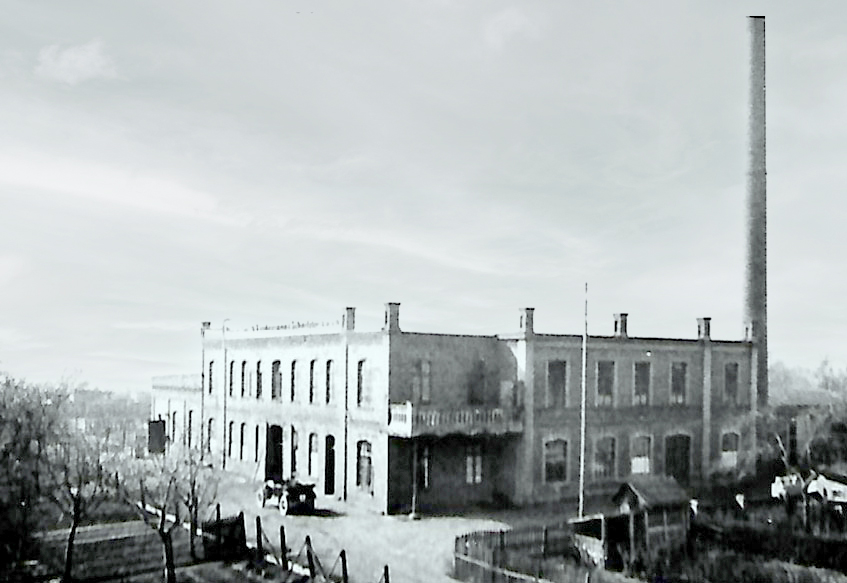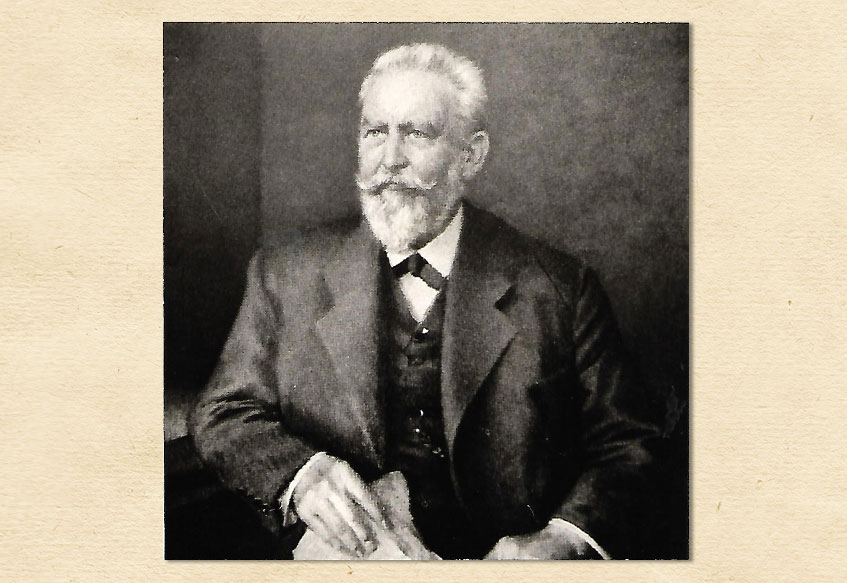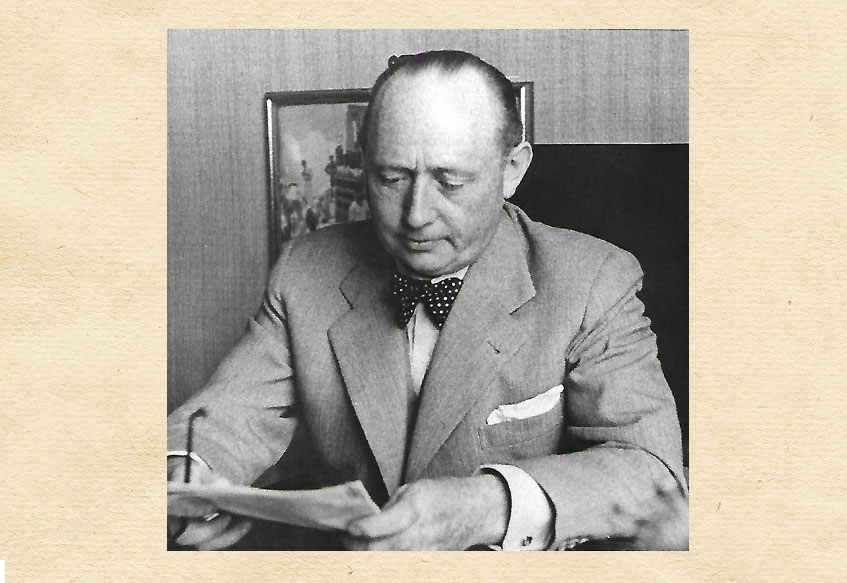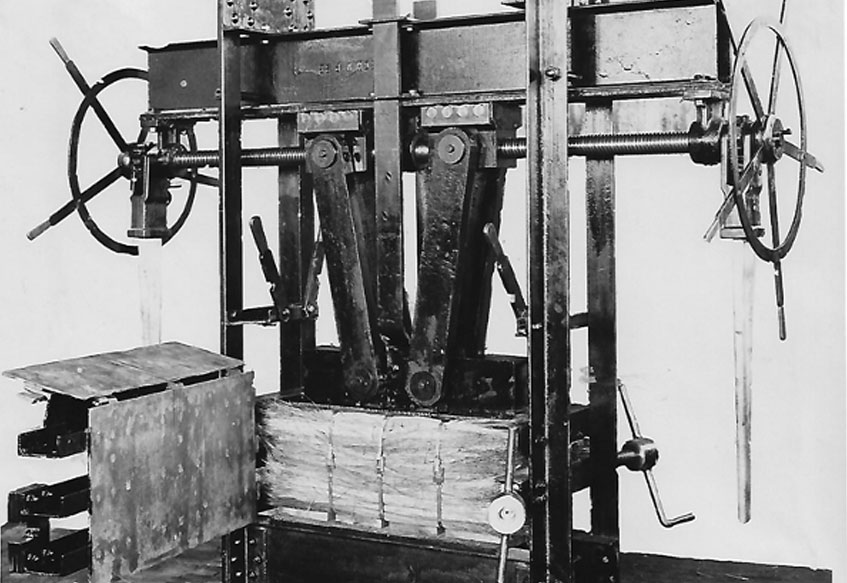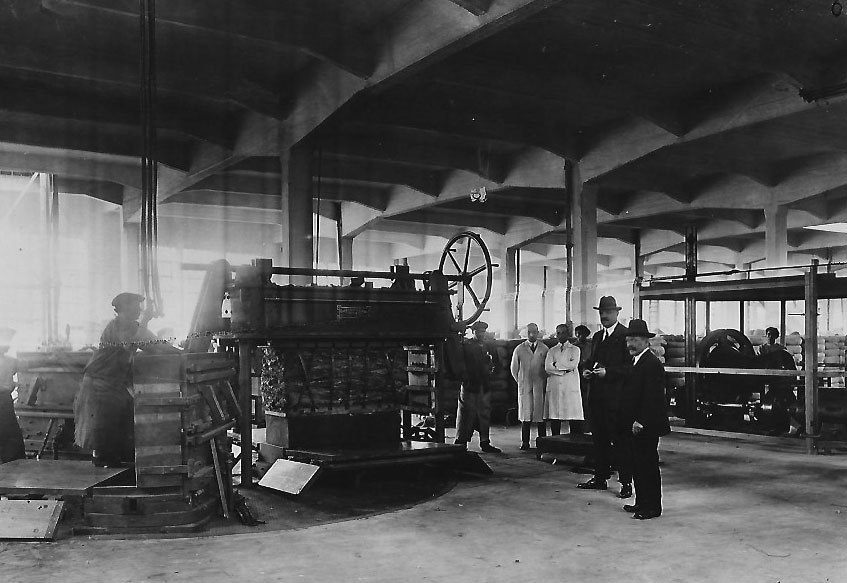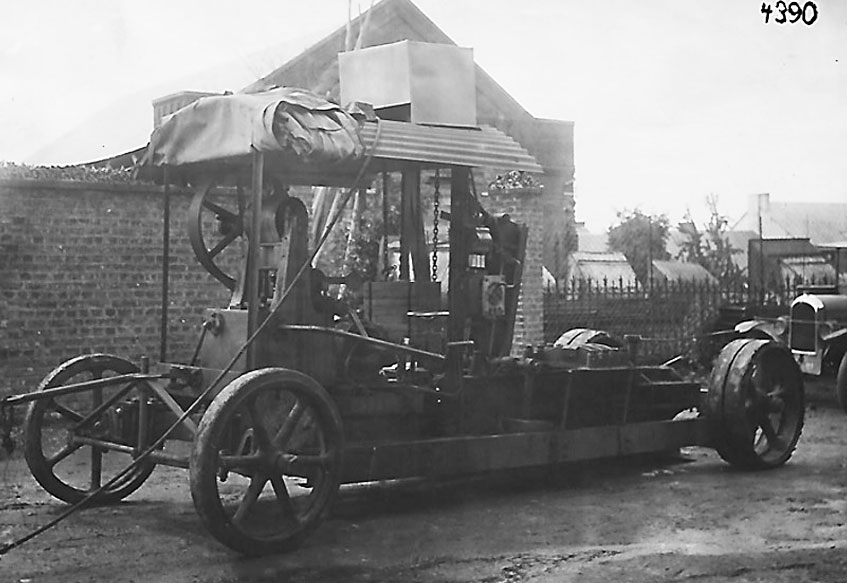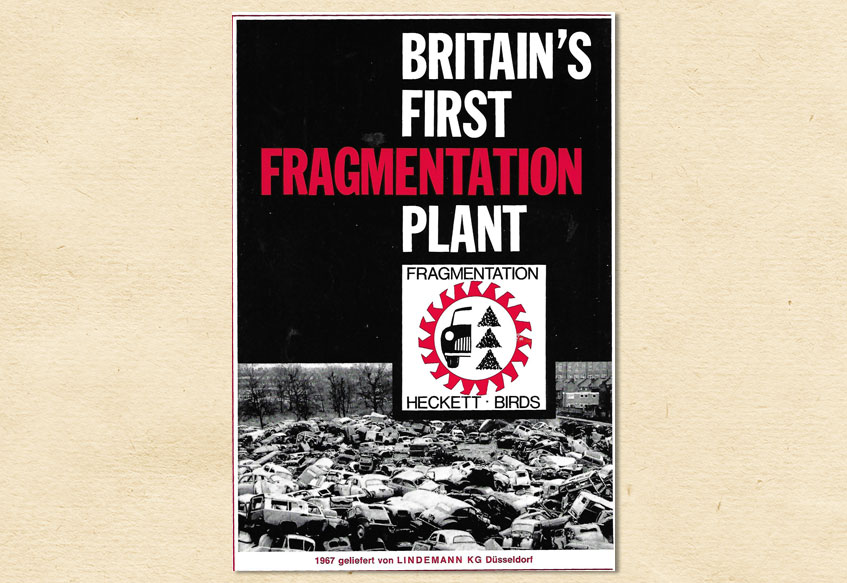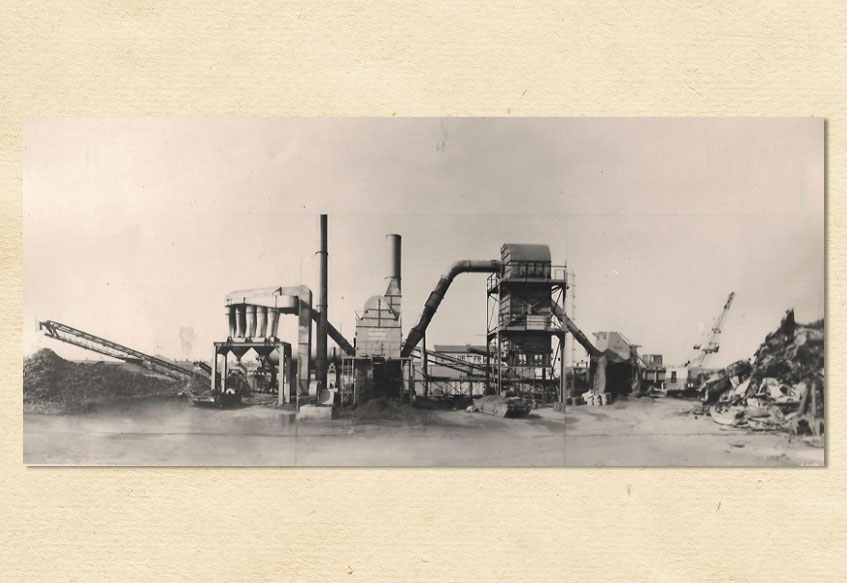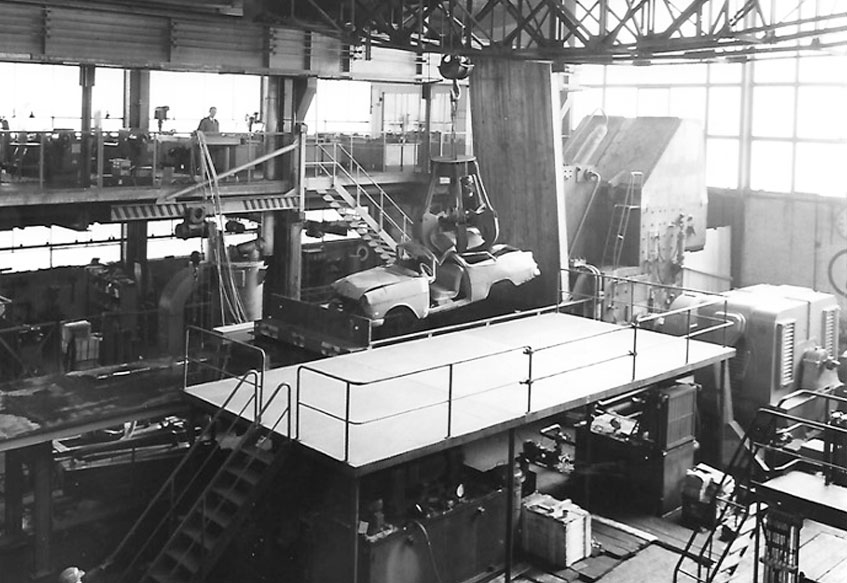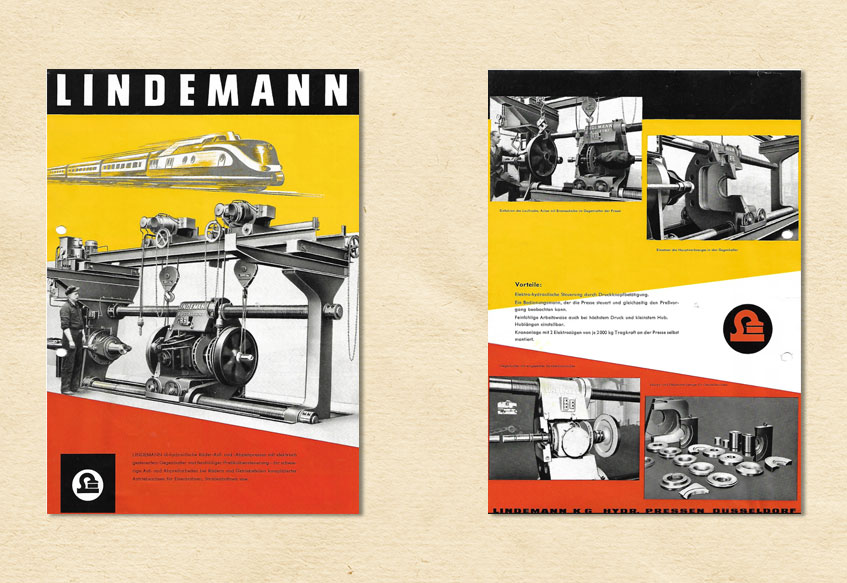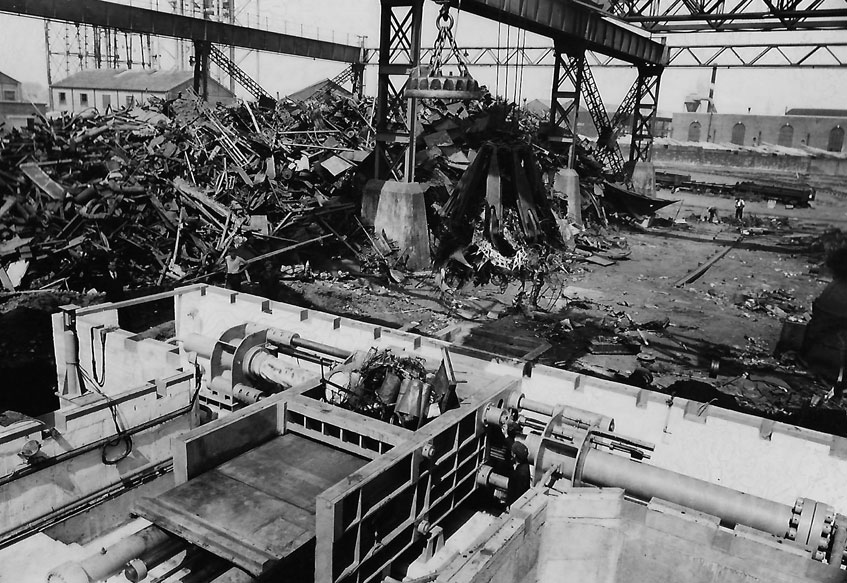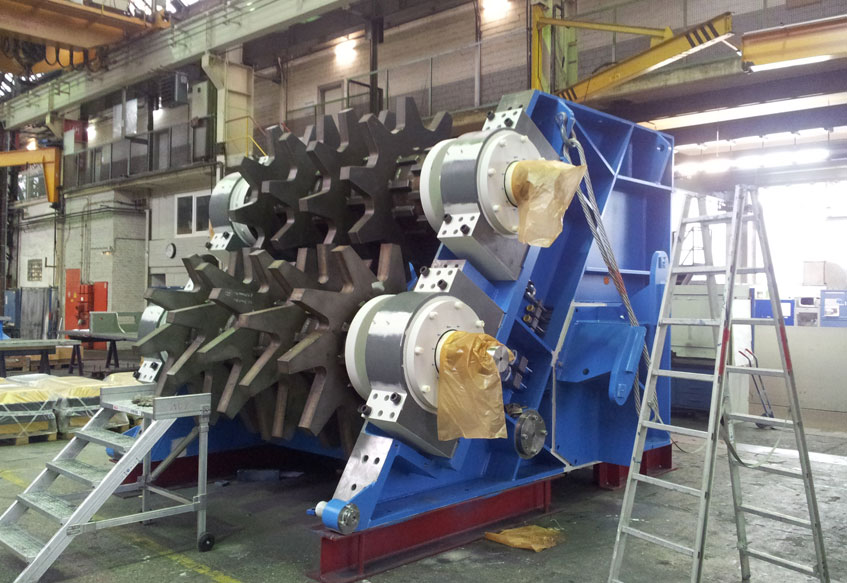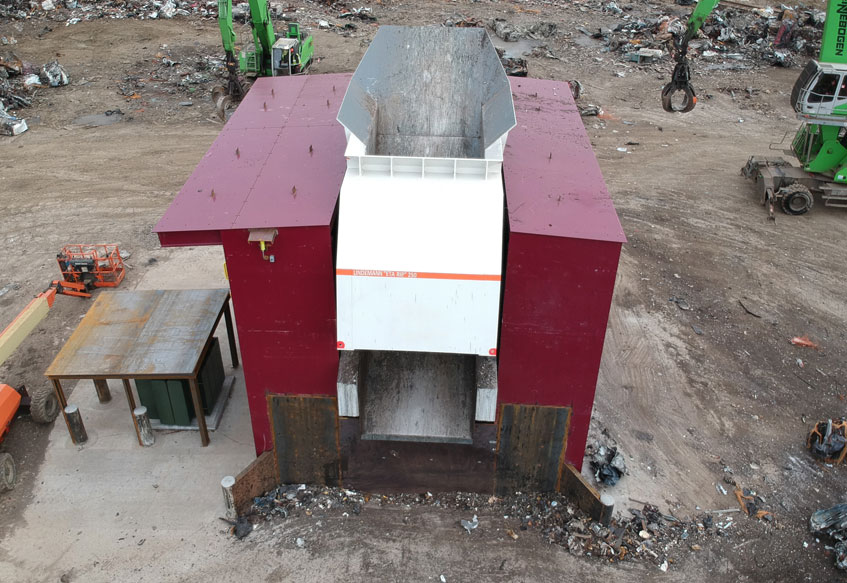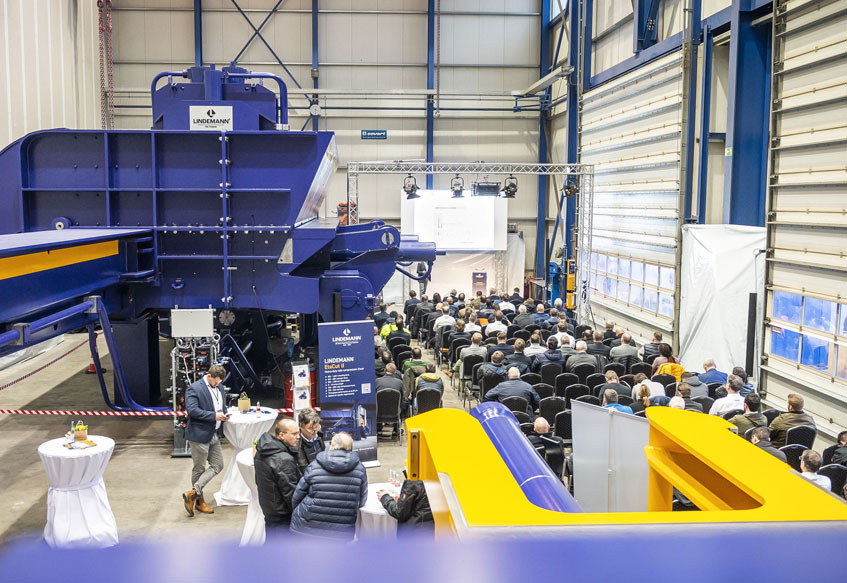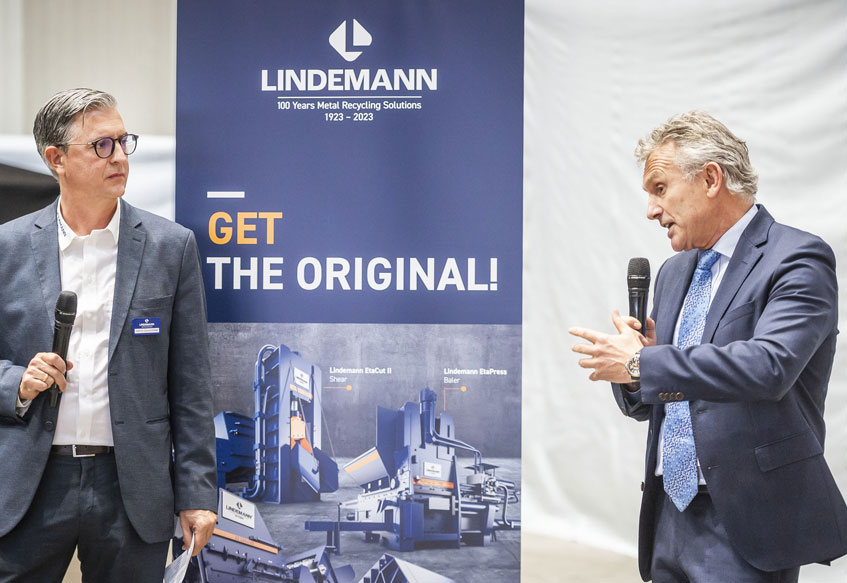
リンデマン110周年 – 金属リサイクル業界と共に100年
歴史

1913年10月1日、27歳のWaldemar Lindemannは、彼自身の名前を付けた商事会社を設立しました。彼がアントワープの貿易事務所で輸出物流を担当しているときに思いついたビジネスのアイデアは、綿、サイザル麻、麻布など、かさばる商品は輸送費がかかるということでした。Waldemarは市場分析を行い、こういった商品を圧縮してコンパクトにできる機械があれば、経済的に魅力があると結論づけます。彼はその考えを進めて、自分自身でプレス機を設計・製造するビジネスを立ち上げます。彼の父親のRobertは油圧のエンジニアとして19世紀末には有名で、プレス機ビジネスの立ち上げに大きく寄与しました。
-
工業化の進展と金属リサイクル
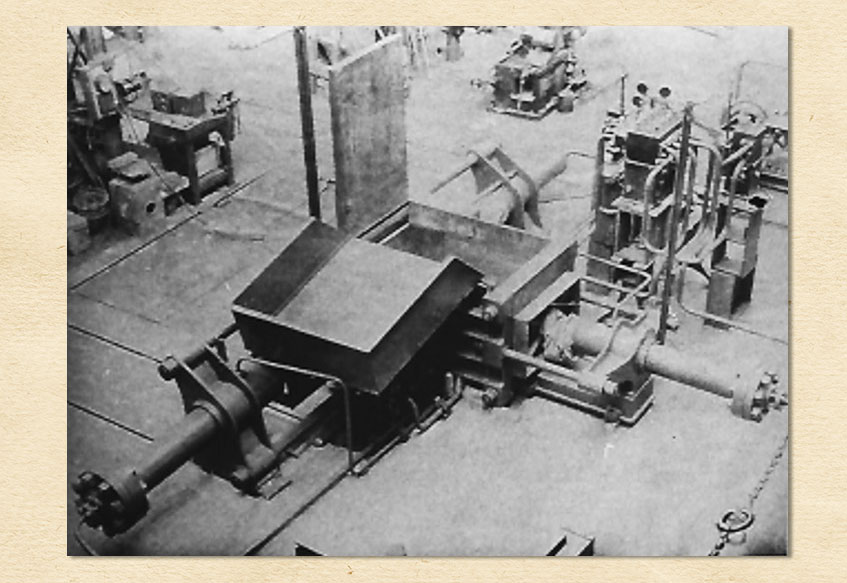
油圧スクラッププレス機「Asper」
1920年代
世界初の金属リサイクル用装置を発売その数年後、Waldemarは、スクラップ処理業界に進出することにしました。その際に、父親が油圧装置の専門家であったことは、非常に大きな価値がありました。その助力もあって、世界初の油圧式スクラッププレスが開発されたのです。 リンデマン社は、1923年、最初のスクラップ用プレス機をイギリスに出荷しました。それは、Robert Lindemannが亡くなった5年後のことでした。それによって、会社は大きく国際的に発展します。ヨーロッパにおける工業化の進展に伴って、金属スクラップをまとめて熔解炉に持ち込む需要が大きく増えていました。1926年には、最初の移動式スクラッププレス機を出荷しました。さらに、1928年末になると、初の大型機である、油圧スクラッププレス機「Asper」が出荷されます。Asperは6m以上の高さがあり、それまでの小型機とは一線を画す処理能力を持っていました
-
金属リサイクル機器業界のリーダーに
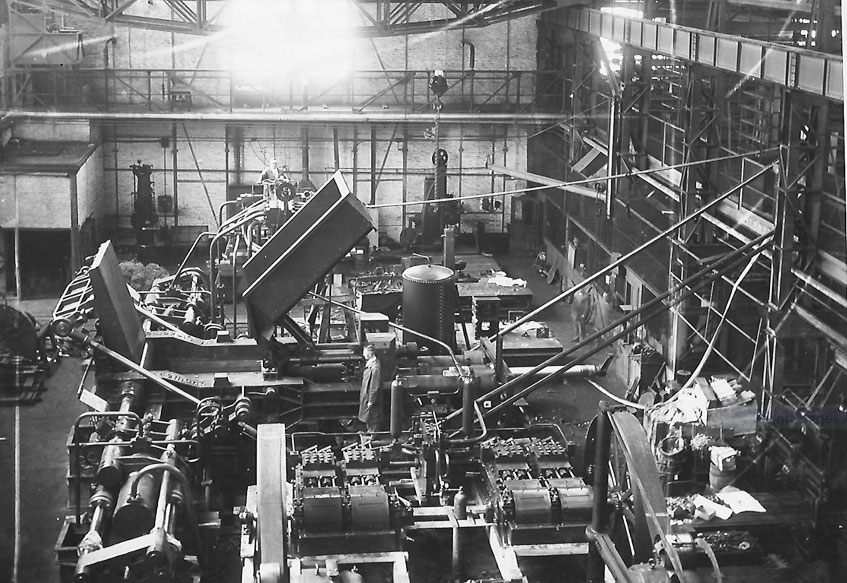
スクラップ用プレス機の組み立て作業場
1930年代
リンデマンの機械がヨーロッパ中のスクラップヤードに1930年代になると、リンデマンの機械はヨーロッパ中のスクラップヤードで見られるようになりました。特に、リンデマンは、さまざまな大きさのスクラップ用プレス機だけでなく、「切削屑圧縮機」を製造して供給し始め、スクラップヤードだけでなく、製鉄所や小規模な金属製造工場でも使われるようになりました。この機械は、たとえば、金属シートの切削屑や、細かい切れ端をブリケットに成形するものです。さらに、最初のスクラップ用シャーを発売しました。アリゲーターシャーと呼ばれる最初のモデルのシャーは、その後30年間で1,200台以上が世界中に販売されました。1931年に、リンデマンの製造工場はOsnabrückからDüsseldorfへ、さらに Oeking AGへと移行しました。
-
戦後期

工場の建物の航空写真
1940年代
古い図面で新しいスタートが可能にドイツ国内の他の製造業のほとんどがそうだったように、第二次世界大戦の戦中~戦後にかけては難しい時期でした。Waldemarが設立した会社は存在しなくなり、リンデマンの工場は接収されて強制的に弾薬を製造させられることとなりました。そしてその工場は、1946年に連合軍によって閉鎖を命じられます。当初は工場も解体される予定でしたが、その命令は放棄され、ただしその代わりとしてすべての建物や製品の図面は没収されました。
幸運にも、CologneにあったWaldemarの兄であるKurt Lindemannの会社が図面を保存しており、それによって新たなスタートを切ることが可能になりました。1947~48年に兄弟は共同でGesellschaft zur Konstruktion Bau Hydraulischer Pressenanlage Lindemann mbH(リンデマン油圧プレスシステム製造会社)という会社を設立し、それが1949年にはLindemann Pressenbau GmbH Köln(リンデマンプレス機製造会社・ケルン)と改称されました。 -
リンデマンのアメリカ進出
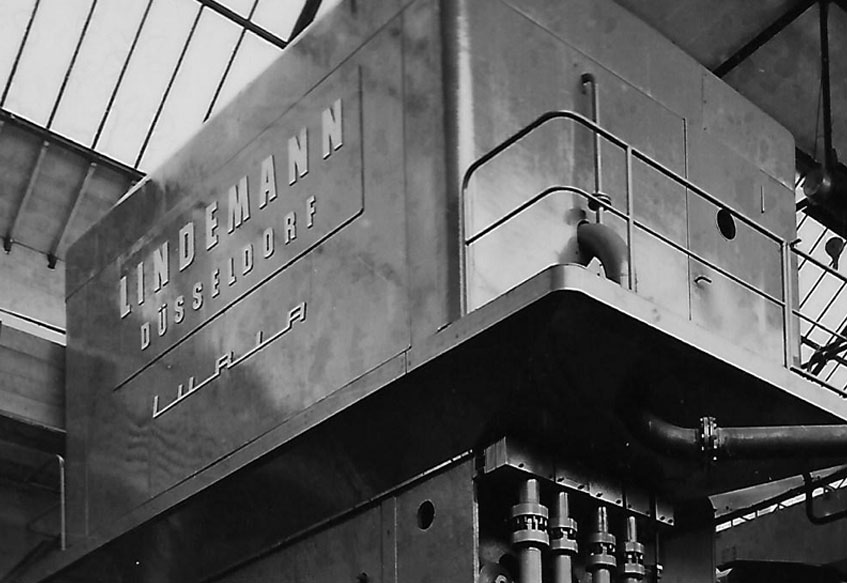
油圧式スクラップシャー(アメリカLuria Brothers社)
1950年代
Lake Erie社との協業で道を切り拓く1952年、会社はデュッセルドルフに戻りました。Waldemarは再度社名をLindemann Maschinenfabrik GmbH Düsseldorf(リンデマン機械製造会社・デュッセルドルフ)に変更して、娘のIngeloreと共にビジネスを推進しました。第二次世界大戦後、大型のスクラッププレス機の需要は爆発的に高まり、Waldemarは1959年には純粋販売会社としてLindemann KGを立ち上げ、アメリカを含む国際市場へ進出する準備を整えました。 同社は、ニューヨーク州バッファローにあった油圧装置の会社であるLake Erie社と提携し、アメリカでの販売を本格的に開始しました。1950年代はスクラップシャーが本格的に普及し始めた時代で、1958年には、世界初の油圧駆動式スクラップシャー(切断力1,200t)が、当時アメリカ最大のスクラップ会社であったLuria Brothers向けに出荷されました。その後、多くの特別製シャーが同様に出荷されています。
-
スクラップシャーの黄金時代
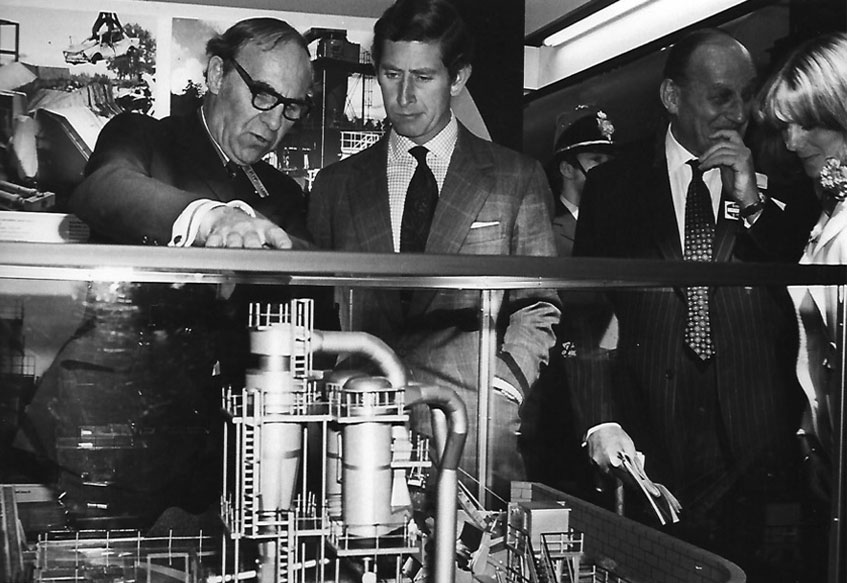
イギリスのシュレッダープラントを視察するチャールズ皇太子
1960年代
世界50ヶ国以上にリンデマン製機械を納品1960年代、スクラップシャーのビジネスは花開きました。同時期に、リンデマンでは、当初はハンマー式破砕機を使って、後に新規で設計した自動車シュレッダーを使って、シュレッダー破砕試験を行っています。その結果は明らかに成功で、というのもその試作シュレッダーは即座に金属スクラップ事業者に買い取られたからです。Waldemar Lindemannは1964年になくなり、娘のIngeloreが単独のオーナーになりました。この頃までに、ビジネスの運営は彼女とは別の経営チームが担うようになっており、その中にはIngeloreの夫であるコンサルタントのSchoemeが加わっていました。リンデマンはデュッセルドルフのHartung Kuhn & Co社を1965年に買収し、生産能力を拡大しました。その後も会社は着実に成長を続け、1960年代中頃には1,000人を超える従業員を抱え、世界の50ヶ国以上に機械が設置されていました。イギリスで最初の大型シュレッダープラントは、1967年にリンデマンが設置しました。
-
シュレッダービジネスの成長

ローターリフト付き750 kWシュレッダー
1980年代
リンデマンはさらに多くの国へNewell社とのシュレッダーに関するライセンス契約は1980年代に終了し、その時点からリンデマンは独自でシュレッダーの開発を続けて、国際的にもシュレッダーのビジネスを成長させています。アメリカの他に、リンデマンはスイス、イギリス、スペイン、ブラジル、フランス、そして日本でも営業を開始しました。
-
Svedala Industries社への売却

1990年代
アメリカにおける新たなチャンス1997年、リンデマンの歴史上初めて、スウェーデンのSvedala industries ABに売却され、社名をSvedala Lindemann GmbHに変更しました。これによって財務体質を強化し、市場での地位を固めることができるようになりました。同時に、アメリカにおけるビジネスも強化されました。Svedala社の傘下にあったハンマーミルシュレッダーのメーカーであるSvedala Universal Engineering社とアメリカ国内のシュレッダービジネスで提携することとなり、さらなる飛躍の礎となりました。Svedalaは鉱物処理装置のメーカーであり、耐摩耗加工の技術を持っていたことから、鋳物製摩耗パーツの開発にも貢献しました。
-
Metsoから再びLINDEMANNに
2000年代
21世紀は、リンデマン社にとって最も成功した時代ですSvedala Industriesがリンデマンを買収してからわずか4年後の2001年、Svedala社自身が、Svedala Lindemann GmbHを含めて、Metso社に買収されました。そのため、社名をMetso Lindemannに変更しました。Metsoは当初、SvedalaとMetsoの既存の金属およびリサイクル処理部門をMetso Mineralsとして統合しようとし、その部門は後にスピンオフしてMetso Recycling部門となりました。Metsoはまた、サンアントニオにあるTexas Shredder社を2005年に買収し、さらにシュレッダーの専門知識を深めました。
2004年から2010年までの間は特に、スクラップ処理設備に対する莫大な需要が発生しており、「リンデマン物語」の中でも、1960年代の再生器に次ぐ繁栄の時代となりました。
2013年にはプレシュレッダーは発売され、1号機はフランスに納入されました。メインとなるシュレッダーの前で粗破砕を行うことで、爆発事故やシュレッダーの摩耗を防止するものです。現在はさらに開発が進み、EtaRipは市場でも最も高性能なプレシュレッダーと見なされています。
2016年にはさらに、中~小規模事業者向け製品として、N-シリーズをラインアップに加えました。最初の製品は、2017年にアメリカ向けに出荷されました。
2022年、リンデマンはLINDEMANNに戻りました。これは、新たなオーナーであるMimir社によるもので、創業者のWaldemar Lindemannの「品質、性能、そして技術革新」というコアバリューに再び焦点を定めると共に、さらなる発展を目指します。同時に、リンデマンは、デジタル化や持続可能性、内部構造と業務プロセスの最適か、新しい人材への投資など、適切な分野への注力を続けます。成長曲線は、予測を上回る速度で進行しています。 -
ハッピーバースデー
2023年
リンデマンは二重の記念すべき年を迎えました。操業の年から110年、金属リサイクル業界に進出してから100年です。J2023年1月12日、リンデマンはBIR代表のTom Bird氏をスペシャルゲストに迎え、金属リサイクリングデーを開催しました。世界中から招待された200人以上の招待客と、国際的な業界誌紙の記者団が、フラッグシップ機であるEtaCut IIやEtaPressを見学し、工場を見学し、Daniela Entzian (BDSV), Philippe Russo (ArcelorMittal), Dr. Walter Hilgert (R&R Beth), Klemens Häusler (Software Management), Karl Hoffmann (STEINERT), Markus Döbbelt (Spaleck)といった業界の有名人の講演に耳を傾け、ゴージャスなディナーに舌鼓を打ちました。

How the LINDEMANN story began
The founding years
Waldemar's father Robert Lindemann was granted permission to build a mechanical workshop as far back as 1893. The apple did not fall far from the tree: For his Lindemann company, Waldemar worked together with his father to develop various baling presses for paper and cardboard, both mechanically and electrically driven, from 1913 onwards. In 1919, Waldemar began the development and construction of baling presses independently of his father.

Industrialization demands metal recycling
The world’s first metal recycling machine entered the market
Waldemar tried to gain a foothold in the scrap processing industry a few years later. His father's hydraulics expertise was invaluable in this respect. This expertise was successfully put to use when the world's first hydraulically operated scrap press was developed. Lindemann delivered it to a customer in England in 1923, five years following the death of Robert Lindemann. It helped the company make its international breakthrough. With the rise of industrialization, the volume of scrap metal that needed to be packaged for transport to the smelting furnace also increased. This was followed by the first mobile scrap press in 1926 and the first end press. Lindemann began building its first large machines at the end of 1928. The "Asper" hydraulic scrap press already measured six meters at the time.

Leading the Metal Recycling Industry
LINDEMANN machines could be found in all the scrap yards of Europe in the 1930s.
Among other things, Lindemann built and supplied "chip mills" as well as various sized scrap baling presses - for scrap yards as well as for steel mills or small, metal processing companies. These were used, for example, for briquetting sheet metal strips and metal chips. Furthermore, the first scrap shears came into the market. Alligator shears, as they were called, constituted the first model of shears, of which 1,200 were sold worldwide over the next 30 years. 1931 saw Lindemann move production from Osnabrück to Düsseldorf to the premises of Oeking AG, on Erkrather Strasse.

After the Second World War
Old drawings made a new start possible
The time shortly before and particularly during World War II was traumatic, as it had been for many manufacturing companies in Germany. The company in the form that Waldemar founded it no longer existed. The LINDEMANN factory found itself being misused for the production of munitions. It was closed by the Allies at the beginning of 1946. It was initially supposed to be dismantled, a decision that was abandoned. Instead, all construction drawings were confiscated. Thankfully, Waldemar's brother Kurt Lindemann's company in Cologne still had drawings that made a new start possible. They founded the Gesellschaft zur Konstruktion Bau Hydraulischer Pressenanlage Lindemann mbH between 1947 and 1948, which was renamed Lindemann Pressenbau GmbH Köln in 1949.

LINDEMANN expand to the USA
Pioneering cooperation with Lake Erie
Operations finally returned to Düsseldorf in 1952. Waldemar once again changed the company's name, to Lindemann Maschinenfabrik GmbH Düsseldorf and, together with his daughter Ingelore, cranked up the business in earnest. The demand for large scrap baling presses increased tremendously after World War II. Waldemar founded Lindemann KG seven years later, starting in 1959 as a pure sales company, paving the way for international trade, including in the USA. Their pioneering cooperation with Lake Erie, a hydraulics company based in Buffalo, was a milestone at the time. Meanwhile, the great era of scrap shears was taking off at the end of the 1950s. In 1958, the world's first hydraulically operated scrap shear, with a shear force of 1,200 t, was delivered to Luria Brothers, the largest scrap company in the USA at the time. Many other special shears followed.

The great age of scrap shears
LINDEMANN presence in more than 50 countries worldwide
The scrap shear business was flourishing in the 1960s. During the same period, LINDEMANN was working on the first shredder tests for crushing metal scrap, at first with a hammer mill, then later with a newly designed automotive shredder. The success was clear to see: Scrap metal processors practically snatched the first automotive shredders out of LINDEMANN's hands. Waldemar Lindemann passed away in 1964 and his daughter Ingelore became the sole owner. As of this date, the operational business was managed by a management team that included Ingelore's husband, General Consul Schoeme. LINDEMANN purchased the Düsseldorf-based company Hartung Kuhn & Co in 1965, boosting the company's own production capacity in the process. The company continued to grow steadily. LINDEMANN already employed 1,000 people by the mid-1960s and had a presence in more than 50 countries worldwide. England's first large-scale shredder lines were installed by LINDEMANN in 1967.

LINDEMANN production for Deutsche Bahn
Demand for pressing metal scrap increased
The scrap presses grew larger and more powerful - the largest hydraulic press of the time was already powered at 750 hp. The demand for pressing new sheet metal scrap increased, especially in automotive factories. LINDEMANN further developed the wheel mounting and dismounting presses for Deutsche Bahn and DÜWAG in Düsseldorf. The shredder business boomed during the same period.

Shredder business grows
LINDEMANN extended to further countries
The license agreement with Newell expired in the 1980s, and from that point on LINDEMANN marketed its shredders without a license, continuously developing them, and significantly expanding its international business. Besides the USA, LINDEMANN established additional sites in Switzerland, England, Spain, Brazil, France, and Japan.

LINDEMANN was sold to Svedala Industries
New opportunities opened up in the USA
LINDEMANN was sold for the first time to Svedala Industries AB from Sweden in 1997. The company name was changed to Svedala Lindemann GmbH. This gave the company financial reinforcement and helped it to secure and further expand its market position. New opportunities opened up in the USA during the same period: Svedala Universal Engineering from Cedar Rapids, which manufactured the Hammersmill shredders, was already part of the Svedala Group, something that was an advantage for the future shredder business. Svedala also contributed valuable expertise in wear casting technology thanks to the construpction of mineral processing machines.

From Metso back to LINDEMANN
21st century is LINDEMANNs most successful business period
Just four years after Svedala Industries bought Lindemann, Svedala itself, including Svedala Lindemann GmbH, was taken over by Metso in 2001 and continued as Metso Lindemann GmbH. Metso initially consolidated Svedala's and Metso's existing metal and recyclables processing segments into Metso Minerals. The business was later spun off into a newly formed division as Metso Recycling. Metso added San Antonio-based Texas Shredder to its portfolio in 2005, thereby expanding its shredding expertise. There was an enormous demand for scrap processing facilities especially between the years 2004 to 2010. It was the most successful business period in the "Lindemann history" so far, next to the formative and strong 1960s. The pre-shredder was launched in 2013 and installed for the first time in France as a shredding element upstream of the shredding process to reduce deflagrations and wear in the expensive main shredder. Today's further enhanced EtaRip is regarded as the most sought-after pre-shredder in the market. The portfolio was expanded to include the N-series in 2016 - for processing smaller and medium scrap volumes. The first delivery was made to the USA in 2017. LINDEMANN returned to being LINDEMANN in 2022. Backed by the investor Mimir, the core values of the founder Waldemar Lindemann “Quality, Performance, and Innovation” will once again be brought into sharper focus and further developed. In doing so, the company is concentrating on relevant topics such as digitalization and sustainability, optimizing internal structures and work processes, and investing in new personnel. The growth curve continues to rise more steeply than expected.

Happy Birthday
LINDEMANN celebrates double anniversary: its establishment and its first steps into the metal recycling industry
January 12, 2023: LINDEMANN started into its centennial with a stunning Metal Recycling Day, held at its production partner Severt, with special guest Tom Bird, President of BIR. Two hundred invited guests from all over the world as well as international trade media press came to see the flagship machines EtaCut II and EtaPress, joined a factory tour, listened to interesting speeches from Daniela Entzian (BDSV), Philippe Russo (ArcelorMittal), Dr. Walter Hilgert (R&R Beth), Klemens Häusler (Software Management), Karl Hoffmann (STEINERT), Markus Döbbelt (Spaleck), and enjoyed the evening with a gorgeous dinner.





